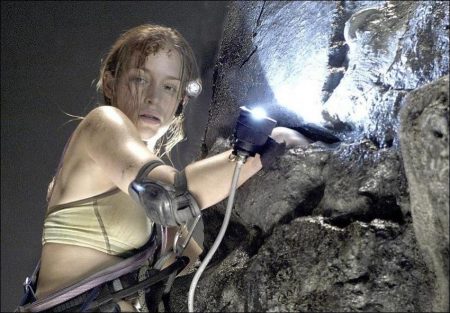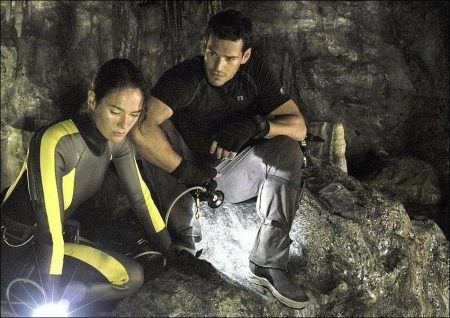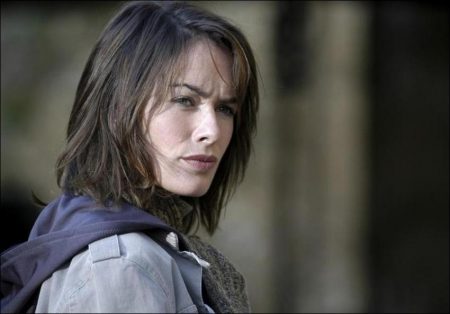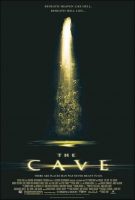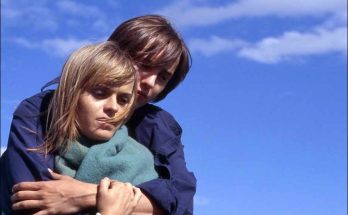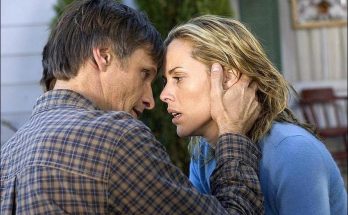Beneath heaven lies hell. Beneath hell lies…
The Cave movie storyline. Deep in the Romanian forest, a team of scientists stumbles upon the ruins of a 13th century Abbey. On further inspection, they make a startling discovery – the Abbey is built over the entrance to a giant underground cave system. Local biologists belive the cave could be home to an undiscovered eco-system, so they hire a group of American cave-explorers to help them investigate its depths.
Jack (Cole Hauser) and his brother Tyler (Eddie Cibrian) are thrill-seeking professional cave explorers who run a team of the top divers in the world. They arrive in Romania with all the latest equipment, including a new type of scuba tank allowing a diver to remain submerged for up to 24 hours.
The Cave is a 2005 American action horror film, directed by Bruce Hunt. It stars Morris Chestnut, Eddie Cibrian, Cole Hauser, Piper Perabo, Lena Headey, Kieran Darcy-Smith, Rick Ravanello, David Kennedy, Brian Steele and Simon Kunz.
In the US, the film opened ranked #5 grossing a poor $6,147,294 at 2,195 sites, averaging $2,800. It went on to have a final US gross of $15,007,991. In Australia, it opened at 89 sites, averaging A$3,204 grossing A$285,121. It had a massive 2nd weekend decrease by 74%, and had a finishing gross of A$570,131. Worldwide, the film has grossed $33,296,457.
The Cave – Art imitating life…
The Cave may appear to be simply the product of a writer’s imagination, but new micro-ecologies have actually been discovered evolving in deep caves, especially in Romania. One of the most famous is the Movila Caves discovery. Acclaimed speleologist and Romanian editor of National Geographic magazine, Dr. Christi Lascu, served as a consultant on The Cave and was present at the Movila discovery.
He says: “The Movila Caves do bear a resemblance to the story of The Cave. It was towards the end of the 1980s when the government wanted to build a huge power plant near Black Sea. My mission was to inspect the soil to see if this land could support such a heavy building. In one of the caves there was sulphuric thermal water full of unusual invertebrate animals.”
“There were probably hundreds of new creatures there, and 35 of them were noted by scientists as brand new species,” he continues. “These creatures only lived in this cave. They are, in a way, living fossils because they have survived millions of years. During the Ice Age these animals became underground refugees, using the thermal water there to survive. An esteemed colleague of mine used the cave discovery for his PhD thesis. He said that if a nuclear war destroyed the planet and all the life of the surface disappeared, that the ecosystem in the Movila Caves would survive because it doesn’t depend on solar energy or food from the surface.”
The Movila discovery was a very big discovery because it was the first underground ecosystem based on chemosynthesis in the world. Among the creatures discovered was a centipede that measured 10cm, and had a poisonous bite. There has also been discovery of amphibian animals in Yugoslavia over 20cm long. No discovery was made of a monster the magnitude of our creature in THE CAVE – but who knows? In theory, there is not a limit for the size of animals living down there. There are large creatures in caves supported by chemosynthesis, so why not?
Andrew Mason explains that although the movie is fiction, the creative team went to great lengths to keep the movie as technically plausible as possible: “We hired some of the greatest cave divers in the world as consultants. We tapped into their experience and put into the script a number of incidents and flavors that relate to things that really happened with people who are diving underground.”
“A cave is an incredibly threatening environment,” he adds. “Apparently one diver in 14 dies each year! So you’ve got that level of danger just in the physical process of moving through the environment. In fact there has been a recent incident in Mexico where a bunch of British cave divers were trapped in caves.”
Diving consultant to THE CAVE and exploration legend, Jill Heinerth, has her own tales to tell: “I was trapped inside an iceberg once while diving in Antarctica. A piece of the iceberg basically closed up the opening where we’d gone in. And then on a subsequent dive my team and I were held back by the current, unable to escape the iceberg. So we’ve had some harrowing experiences. The underwater DP for this film, Wes Skiles, was once trapped with 13 people inside a cave in Australia and had to dig his way to safety over a period of days. So they are scary places!”
Richard Wright adds: “We worked incredibly hard on this script. It’s a deceptively complicated story, and we had to respect the basic underlying science. We were dealing with completely closed ecosystems, chemosynthetic life forms and the physics and safety procedures of cave diving. There’s a lot of technical and scientific information that’s woven into this script that you don’t necessarily realize, but we hope that all the experts and enthusiasts will watch the film and – allowing of course for a certain dramatic license – will think ‘Wow, they really did their homework’.”
Getting Started
Australian Executive Producer Andrew Mason on (the Matrix Trilogy), discovered the script by L.A.-based writers Michael Steinberg and Tegan West while in L.A. on business in 1999. “I loved it immediately,” he says. “I thought it was a great and original take on classic horror thriller films that rely on imagination terror rather than the scare of seeing something in particular, so I grabbed it. I spoke to the guys at Lakeshore, Gary Lucchesi and Tom Rosenberg, who also liked the script immediately, and liked Bruce Hunt’s work, who I was proposing as director. We formed a partnership and away we went.”
Producer Gary Lucchesi, thought the screenplay was very commercial and an interesting idea. “When I first read the screenplay, I was reminded of Ridley Scott’s Aliens, which was a movie that had a great effect on me almost twenty years ago. I thought it was sophisticated, scary, and stylistically accomplished, but was also tremendously credible in terms of how it was directed. It didn’t pull a lot of tricks.”
After viewing Hunt’s reel, Lucchesi knew the director could pull off a first feature with this movie. “I brought the project to Screen Gems, who I thought would be natural partners for us since we had great success on Arlington Road, The Mothman Prophecies and Underworld with them. I also knew that teaming with a first-time director could be risky, but never worried about Bruce Hunt. Bruce is not a first-time director. He’s been directing for fifteen years and is perhaps the most renowned commercial director in Australia. He just hadn’t directed a feature yet. He shot second unit on huge films including The Matrix, so in terms of being comfortable with the camera, shooting action, and working with actors, we felt that he could achieve all of that very successfully.”
Producer Richard Wright says, “this was an extraordinarily difficult movie to make. One of the nice things about having Bruce do the movie (beyond his own creative skills, which are considerable) was that he brought a lot of his Australian crew with him. They are utterly devoted to him and would do anything for him. As a result we’ve accomplished things that ordinarily we would not have been able to do.”
The Cave (2005)
Directed by: Bruce Hunt
Starring: Morris Chestnut, Eddie Cibrian, Cole Hauser, Piper Perabo, Lena Headey, Kieran Darcy-Smith, Rick Ravanello, David Kennedy, Brian Steele, Simon Kunz
Screenplay by: Michael Steinberg
Production Design by: Pier Luigi Basile
Cinematography by: Ross Emery
Film Editing by: Brian Berdan
Set Decoration by: Malcolm Stone
Costume Design by: Wendy Partridge
Art Direction by: Cristian Corvin, Enrico Fiorentini, Vlad Vieru
Music by: Reinhold Heil, Johnny Klimek
MPAA Rating: PG-13 for intense creature violence.
Distributed by: Sony ScreenGems
Release Date: August 26, 2005
Views: 92
